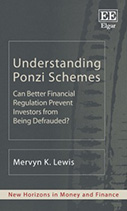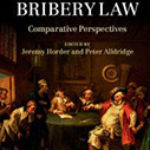Understanding Ponzi Schemes: Can Better Financial Regulation Prevent Investors from Being Defrauded?

Author: Mervyn K. Lewis
Publisher: Cheltenham, UK; Northampton, MA: Edward Elgar Publishing, 2015. 190p.
Reviewers: Yiyan Li and Hongming Cheng | September 2016
On the back cover of this well-informed and topical book on Ponzi schemes, Eva Lomnicka writes, “[a] ‘must read’ for regulatory policy-makers and a fascinating read for the general reader, Professor Lewis is to be congratulated for advancing the debate on this age-old phenomenon by suggesting distinctive and innovative strategies to tackle it.” Similarly, Stephen Greenspan also writes, “Mervyn Lewis has written what is probably the best and most comprehensive book on the topic.” We could not agree more with both Lomnicka and Greenspan. We note that more than two dozen books on Ponzi schemes have now been written, but ‘Understanding Ponzi Schemes” provides a most informative and detailed analysis of this phenomenon based on the author’s theoretical analysis and empirical case studies.
Ponzi schemes take many creative forms, and some new forms are even more complicated to detect. The economic system’s reliance on a free market, combined with the ineffectiveness of regulation, makes it difficult to differentiate between legal business ventures and fraudulent schemes. The subject of Lewis’s Understanding Ponzi Schemes is significant, as Ponzi schemes are a kind of investment fraud that occurs frequently around the world. Lewis notes that his motivation for writing the book was the result of his shock over a Ponzi fraud in his local community. He does a superb job of offering a systematic description of what Ponzi schemes are, how they happen, why people fall for them, how they are able to survive for long periods of time, what we can do to avoid being victims, and ways of preventing them.
Besides chapter 1 (outline) and chapter 12 (summary), the book is divided into three parts: the first part (chapter 2 and chapter 3) explains what Ponzi schemes are and outlines their historical background; the second part (chapter 4 to chapter 7) examines several representative cases of Ponzi schemes; and the third part (chapter 8 to chapter 11) provides deep insights into how Ponzi schemes work and suggestions for avoiding falling prey to them.
In Chapter 2, “How do Ponzi schemes work? Comparing them to other financial activities,” Lewis introduces the basic concepts of Ponzi schemes, and differentiates them from other financial activities. He begins by providing a definition that emphasizes how money returns from Ponzi schemes come from the money of subsequent investors rather than from real business activities. Lewis points out how fraudsters lure investors by creating a narrative of a bright future with “advanced” investments that yield returns that are both high in the short-term and stable in the long-term. The entire system is predicated on motivating early investors to persuade more people to join in, thereby introducing new money into the scheme. Lewis then sharpens his definition by distinguishing Ponzi schemes from Pyramid schemes, Ponzi finances, and social security. For example, although social security relies on younger workers supporting the older population, both population growth and new technology will produce enough wealth to support later entrants. In other words, misrepresentation and violation of trust are essential features of Ponzi schemes, and high consistent returns with low risks are their most misleading feature.
In Chapter 3, the author examines the machinations of Charles Ponzi, the inventor of the Ponzi scheme. In 1919, Ponzi used International Reply Coupons (IRCs) to promote small-scale exchanges by saving the cost of return postage, and this program was able to attract around 40,000 people and a total cash flow of around 15 million dollars (equal to approximately 162 million dollars today) in only seven months. Ponzi promised a 50 per cent return on investment within three months, but this never fully materialized as he did not put all of the investment money towards buying coupons. In fact, he paid returns to early investors using money from later investors who never saw any return from their capital. Lewis cites three reasons that contributed to the popularity of Ponzi’s scheme: promised high returns, apparent low-risk and the good reputation of Ponzi and of the company. Although Ponzi did use some of the money for real investments, most of it was used to finance his lavish lifestyle. Ponzi’s fraud was finally exposed by a financial journalist working for the Boston Post.
Chapter 4 examines Bernie Madoff’s Ponzi scheme, which is the largest in US history in terms of longevity and scale of losses, with about 36 billion dollars flowing into Madoff’s scheme between the early 1990s and 2009. Madoff began his false returns to clients’ accounts as a result of “embarrassing losses with a European bank in the early 1990s” (p.411). However, those returns never made it to their destination. One of the reasons for the longevity of Madoff’s fraud was the promised return rate, which provided an air of credibility. Unlike Charles Ponzi’s scheme, he did not provide unbelievably high returns to investors, but rather more “reasonable” annual return rates ranging between 10-13% regardless of whether the market was good or bad. Lewis introduces red flags, which he defines as abnormal behaviours, as an analytical tool for identifying Ponzi schemes. These anomalies are divided into three categories: behavioural, statistical, and organizational. Behavioural anomalies are related to the lavish lifestyle. In this case, Madoff had bought extravagant houses in several states. Statistical red flags indicate numbers that seem unusual, including the return rate of 11 percent over two decades. Organizational red flags refer to characteristics which differentiate a particular business from others. Ultimately, Madoff’s scheme came to an end in 2008 as a result of a liquidity crisis that was brought on by the large financial crisis in US.
In Chapter 5, Lewis analyzes another large Ponzi scheme run by Allan Stanford. Stanford was a billionaire, entrepreneur, and philanthropist, which all helped to establish his image as a trustworthy person. Stanford’s Ponzi scheme lasted for more than 10 years, and its core means of generating income was the selling of certificates of deposits (CDs) through Stanford International Bank (SIB). This bank was controlled by the Stanford Financial Group (SFG), a corporation that was founded by Allan Stanford. Unlike Charles Ponzi and Bernie Madoff, SIB’s offered rate of return was only 1 or 2 per cent higher than a usual bank rate. Early warnings of Stanford’s Ponzi scheme began to emerge in 2003, when two employees spoke out, and a letter which revealed problems in SIB came to the attention of the Financial Industry Regulatory Authority (FINRA). Investigations into Stanford’s operation finally began when a financial analyst presented evidence to support the claim that Stanford was running a Ponzi scheme. This investigation led to Stanford’s arrest in 2009 and the end of his scheme. Authorities, including the Securities and Exchange Commission (SEC), were blamed for failing to recognize Stanford’s scheme.
To clearly illustrate the features of Ponzi schemes, the book describes five other cases that all have features of being an affinity fraud. For instance, Kenneth Wayne McLeod’s Ponzi scheme, which targeted FBI agents. McLeod utilized retirement program seminars to sell a confidential, but fake Federal Employees Benefits Group (FEBG) Bond Fund to FBI agents and employees, which attracted about $34 million from 260 people. McLeod’s scheme came to an end in 2010 after he was investigated by the SEC and FINRA. Another example is Allan McFarlane’s Ponzi scheme, which is one that Lewis witnessed first-hand. McFarlane’s scheme was conducted in a regional community located in South Australia, and was a typical case of affinity fraud. Besides defrauding the local community, McFarlane took advantage of his close relationship with Christian groups and disability-related support groups. Unfortunately, McFarlane’s scheme was not revealed until after his sudden death.
Chapter 7 introduces a Ponzi scheme that targeted a particular religious group—the Amish. The Amish are descendants of the early eighteenth century Swiss migrants to the United States, and are famous for their economic acumen, and their insistence on maintaining a “horse-and-buggy lifestyle”. However, groups like the Amish are particularly vulnerable to Ponzi frauds. The author examines three cases: John M. Sensenig, Monroe L. Beachy, and Timothy Eugene Moffitt. A common feature of these cases is that they all took advantage of the high level of trust inherent in Amish communities. For instance, by promising to create a recreational vehicle (RV) park, Moffitt was able to attract 82 Amish families to invest nearly $20 million in the project. Except for the 126.98 acres of land, he did not make any real investments. While this scheme collapsed and Moffitt was arrested, some of the victims still believed in Moffitt’s commitment.
In Chapter 8, “What can Behavioural Finance tell us?”, Lewis provides a schematic for making investment decisions. It is a common belief that people become victims of Ponzi schemes because they are greedy or gullible; however, Lewis points out that the true problems are not the greed or gullibility of the victims, but the fraudsters themselves and the nature of their schemes. Lewis cites David C. Rose (2011), who examined the inter-relationships among empathy, sympathy and guilt, arguing that a high trust community such as a small group — one with good cultural values — wouldn’t have the problem of fraud since people would feel guilty about cheating. Lewis argues, however, that small groups are not immune from being affected by Ponzi schemes (i.e. the Timothy Moffitt case), for it is hard to detect when a con man is violating implicit or explicit trust.
Lewis also discusses Behavioural Finance theory, which is based on cognitive psychology and experiments that study the processes involved in making decisions. In this theory, there are two systems of cognition: system 1, which refers to the elephant (intuitions, or thinking fast), and system 2 which refers to the rider (reasoning, or thinking slow). Although these two systems are inter-related and people are able to make rational decisions, they sometimes cannot do so when it comes to market decisions where they don’t have sufficient information. This theory helps explain the behaviour of Ponzi-scheme investors.
In Chapter 9, the author draws upon psychological research to explain and explore the mentality of victims and perpetrators in Ponzi schemes. Stephen Greenspan, who is a psychologist and a victim of Madoff’s Ponzi scheme, developed a model to explain the gullibility of victims. In his model, four factors influence a gullible outcome: situation, cognition, personality, and emotion. The first factor, situation, refers to the way con men present themselves. Like Behavioural Finance, the second factor, cognition, is related to decision-making. The third factor is personality, which means a person is trusting and unwilling to say no. The fourth factor, emotion, underpins the desire to make more money or to make safe and secure investments. In this sense, a trusting person who would like to have a secure retirement may invest money in a seemingly reputable fund (Ponzi scheme) without making any sophisticated considerations. In terms of the mentality of the perpetrator, Lewis offers clues from Madoff’s interview (in prison) and draws upon analyses by psychologists. For instance, Madoff stated that he thought he could have made things work out, and that he didn’t think he was running a Ponzi scheme.
Chapter 10, “What can be done about Ponzi schemes?”, provides suggestions on how people can avoid being victimized by Ponzi schemes. According to Lewis, three concepts should be kept in mind in order to avoid falling prey to a Ponzi scheme: “trust and decision-making, auditing and stewardship, and regulation and fraud” (p. 147). Although there is a debate as to whether or not regulations can effectively detect frauds, Henriques (2011), as cited by the book, proposes three mechanisms that might be helpful in curbing Ponzi schemes: create safe investments, licensing investors, and more serious punishments for fraudsters. Besides these, Lewis suggests several statistical techniques which can help investors in a practical way. For affinity frauds, a self-assessment exercise is provided.
On the whole, this book offers highly valuable information about Ponzi schemes. The writing is clear and well organized, and it is an excellent work not only for academic researchers, policy makers, and students, but it can also be valuable to general readers.
References
Henriques, D. B. (2011). The Wizard of Lies: Bernie Madoff and the Death of Trust. New York: Times Books.
Rose, D. C. (2011). The Moral Foundation of Economic Behavior. New York: Oxford University Press.
Yiyan Li, PhD student, Department of Sociology, University of Saskatchewan, Canada
Hongming Cheng, LL.M., Ph.D., Associate Professor, Department of Sociology, University of Saskatchewan, Canada


